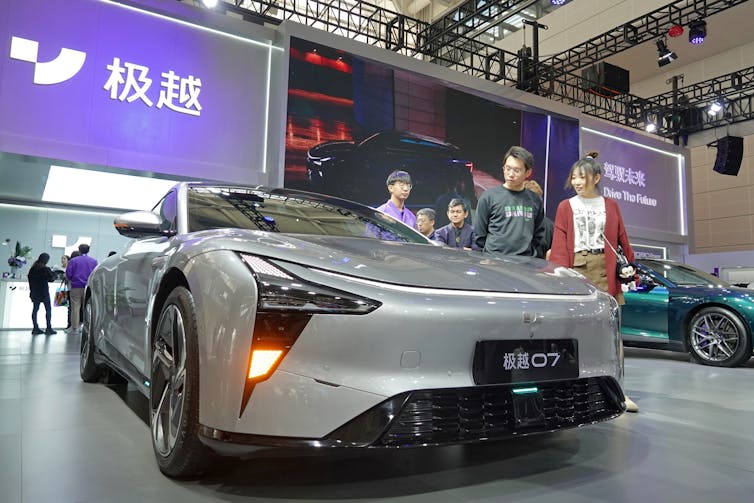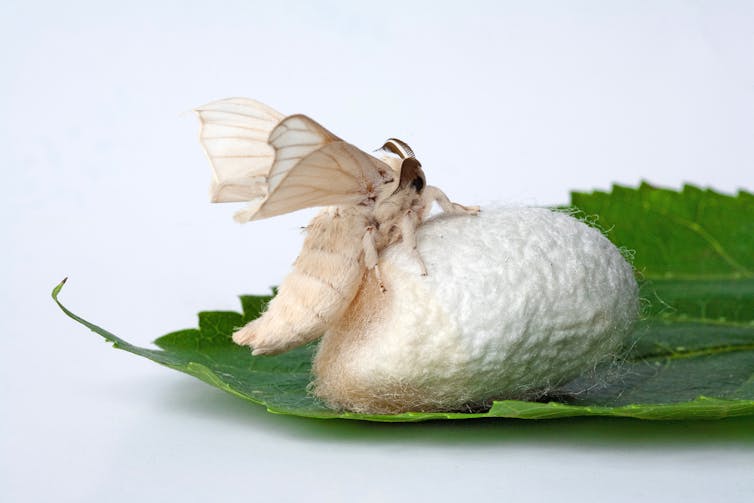
Costfoto/NurPhoto via Getty Images
When Donald Trump returns to the White House, he’ll be accompanied by a coterie of China hawks, all vowing to use tariffs and export bans to stop Beijing from challenging the United States’ supremacy in technology.
This isn’t entirely new; China has faced such trade pressure since Trump first became president in 2017, and it has continued through the Biden administration.
But the scale of what Trump now proposes – he has mentioned tariffs of up to 60% on goods from China – has some commentators suggesting that it could, in the words of one analyst, “keep Beijing on the defensive and permanently transform the rivalry in America’s favor.”
Such a view is premised on the belief that China’s outdated, state-subsidized, manufacturing-for-export model is ripe for disruption by U.S. tariffs.
But as someone who has studied China’s technology since the early 2000s and written and edited two books on China and innovation, I believe this portrayal of China’s economy is at least two decades out of date. China’s technological sectors have grown rapidly after 2016 by adapting to the imposition of American tariffs. Indeed, since the “trade war” launched by Trump in 2017, Chinese technology has actually emerged as a world leader.
China’s tech ascent
Thirty years ago, China barely had internet access, and its best technology company was yet to produce a competitive personal computer domestically. Fifteen years ago, it was the world’s factory – stuck at the low end of the value chain assembling iPhones and other tech gadgets, but not able to make any high-tech parts itself.
Even with the best crystal ball in the mid-2000s, no Chinese planners could have predicted the pathways to China’s technological standing today.
Fast-forward to today: China is now ahead of rival economies across broad technological fields. The think tank Information Technology and Innovation Foundation found in a 2024 report that China is leading or globally competitive in five out of nine high-tech sectors – robotics, nuclear power, electric vehicles, artificial intelligence and quantum computing – and rapidly catching up in four others: chemicals, machine tools, biopharmaceuticals and semiconductors. A Bloomberg analysis similarly identified China as leading or globally competitive in 12 out of 13 technology-intensive industries. And the Australian Strategic Policy Institute found China leading in 37 of 44 critical technologies it tracked.
Why has the Chinese tech industry advanced so quickly? Many in Washington believe it’s the result of decades of careful government planning to dominate global high-tech industries. But this, I believe, vastly overestimates Beijing’s foresight and control. The Chinese government has indeed maintained the lofty goal of catching up with the West since the 1980s, but having goals isn’t the same as being able to execute them.

STR/AFP via Getty Images
Many in the West also point at Chinese state subsidies propping up domestic tech firms. While subsidies have played a role in some tech successes, the Chinese government has also funded plenty of failures. Take semiconductors, for example: Despite enormous Chinese government investments since the 1990s, China still lags in producing cutting-edge chips and is reliant on imports.
Dare to D.R.E.A.M.
In my view, China’s technological dynamism didn’t come from the magic of central planning, but through five key elements I call D.R.E.A.M..
D denotes the dialogue between state and market.
While China’s government wields significant power, the country’s private sector is neither submissive nor powerless. In 2022, firms not owned by the state – mostly private firms but also offshore firms in which Beijing does not have a controlling share – accounted for 95% of enterprise R&D spending and 88% of urban employment.
While Beijing has cracked down on tech giants – it banned Alibaba’s Ant Group from listing on the New York Stock Exchange in 2020, and its COVID-19 lockdown hurt its private sector – the government is not, contrary to how it is seen by many in the West, bound by strict ideology. It has recently started to voice more support for the private sector, even drafting laws to protect private companies.
Indeed, it’s more accurate to describe state-market relations in China as dynamic, adaptive interaction – more dialogue than dictatorship.
R refers to the domestic research and development (R&D).
Once reliant on imported technology, China has invested heavily in domestic research capacity over the past 20 years. Geopolitical tensions accelerated a shift toward self-reliance, but Chinese scientists and engineers remain deeply engaged in global networks.
Further, a nominally anti-espionage program brought in under Trump’s first administration has swelled the number of highly skilled workers in China. The “China initiative” introduced by the U.S. Justice Department in 2018 promoted the suspicion – often without evidence – that Chinese and Chinese American scientists might be spying for Beijing, resulting in a flood of leading scientists heading back to China. There they continued to undertake cutting-edge research and educate a new generation of Chinese scientists.
E is for the industrial ecosystem China can exploit.
China’s vast manufacturing base enables rapid creation and scaling of new technologies. In 2023, China produced 35% of the global gross manufacturing output, being the only country covering all major industrial sectors.
China may not have the innovative ecosystem of Silicon Valley, which can draw on deep venture capital and a booming stock market. But it has built comprehensive supply chains over the years, and it’s exceptionally good at repurposing them to rapidly bring new products to market.
Take the example of robotics. China took the robotics industry seriously only when labor costs rose sharply. In 2010, China’s manufacturing labor costs were about $2 per hour, similar to the Philippines or Vietnam; by 2022, that figure rose to about $8 per hour – more than double the average of Southeast Asian countries.
China now installs more industrial robots annually than the rest of the world combined, and the quality of its robots has grown by leaps and bounds.
A stands for accumulative changes.
Rather than aiming for novel breakthroughs, Chinese companies excel at incremental improvements – and this results in an accumulative transforming effect. The massive manufacturing networks create opportunities to improve upon existing products based on market feedback, rather than a few brilliant ideas from any leader’s creative mind.
Analysts in the U.S. have long expected China’s rampant intellectual property violations to doom its innovation drive, the thinking being that it takes away the impetus for individuals to innovate if they believe such innovations will be stolen. Instead, as Taiwanese tech expert and writer Kai-Fu Lee has explained, Chinese enterprises can be dynamic and innovative in an environment with less IP protection. They often rapidly expand their market share and build business ecosystems to prevent followers from catching up.
M means the middle market.
Chinese firms tend to target middle-income consumers, both domestically and globally. By prioritizing affordability and functionality over cutting-edge innovation, they avoid head-to-head competition with Western giants such as Apple.
Chinese smartphone brands such as Xiaomi and Oppo are a third to half the price of an iPhone, but with similar functionalities. Chinese electric vehicles are similarly far less expensive than Tesla but still incorporate leading features.
Chinese firms tolerate lower profit margins, as they can rely on the expanded sales in the middle market, both domestically and, increasingly, overseas.

CFOTO/Future Publishing via Getty Images
Tariffs as a counterproductive measure
The problem for the incoming Trump administration is that while tariffs might alter the global map of China’s manufacturing and exports, they won’t dismantle any of the D.R.E.A.M. elements. In fact, they could have the opposite effect of accelerating China’s push for self-reliance and strengthening its foothold in global middle markets.
Part of the problem is that American policymakers often see technological competition with China as a zero-sum contest. But technological competition isn’t like a race with distinct lanes and a finish line. Rather, tech transformation is a complex process in which countries and companies compete, collaborate and build on each other’s work.
Ultimately, America’s technological prowess won’t be measured by how much it manages to stop China, but by how successfully American companies can address humanity’s greatest challenges. Attempts to hobble the competition through tariffs and trade wars will do little toward that end.
Yu Zhou, Professor of Economic Geography, Vassar College
This article is republished from The Conversation under a Creative Commons license. Read the original article.
































































